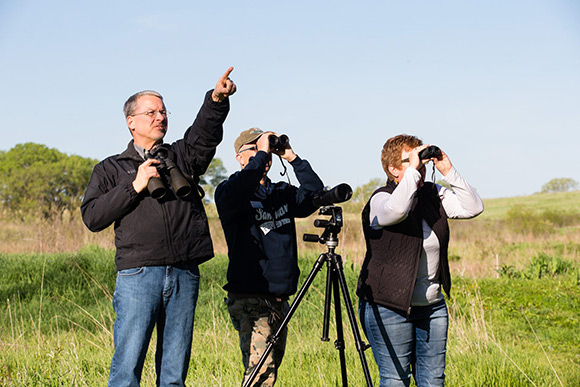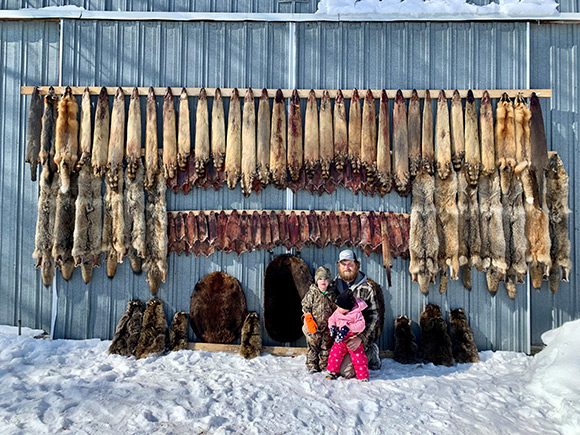 Team Fur News - May23
Team Fur News - May23
New FUR-FISH-GAME Editor
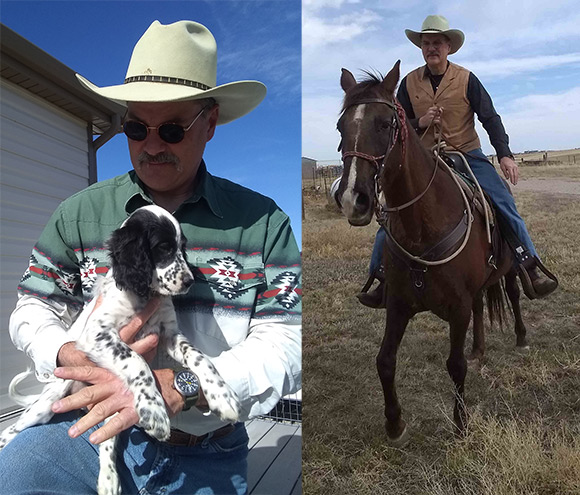
New FUR-FISH-GAME editor John D. Taylor with his English setter puppy Willa, and on his Tennessee Walking horse Ribbon.
Readers may notice some small changes in FUR-FISH-GAME with the last several issues. That’s because there’s a new editor on board. After nearly 35years at the helm of the magazine, Mitch Cox, a FUR-FISH-GAME institution, retired in December. Taylor steps in to fill Cox’s very big shoes. Taylor, who lives in Wyoming and works remotely, has had a wealth of outdoor experience. Originally from Pennsylvania, he has hunted big game, upland birds, turkeys, waterfowl and predators in 22 states, trapped and fished across the country. Most recently Taylor served as an editor for newspapers in both Dakotas, Montana and Wyoming, and managing editor for a pro-Second Amendment group in Texas. He is married to Nancy Whiting, and they share a home with two Ryman-type English setters and two Tennessee Walking horses. Taylor isn’t exactly new to FUR-FISH-GAME. The first outdoor article he ever published was in F-F-G many years ago. “My aim is to keep FUR-FISH-GAME the best outdoor magazine going, I won’t fix what ain’t broke here,” Taylor said. “Yet I’m open to new voices, new ideas for sharing the outdoor experience.”
Nebraska to hold first Birding Bowl
Bird watchers can help contribute data for bird conservation, and win prizes, in Nebraska’s first Birding Bowl.
May is bird month in Nebraska, and the Nebraska Game and Parks Commission, Audubon Great Plains and the Wild Bird Habitat Store, are launching the first Nebraska Birding Bowl, a free, statewide birding competition during May. Participants can compete as an individual or a team and have a chance to win prizes that include bird feeders, a pair of Vortex binoculars, or up to a $1,000 cash prize. There are endless opportunities to observe birds in Nebraska during May, from viewing songbirds in parks, shorebirds in wetlands, observing common backyard birds, to attending one of the many guided Nebraska Bird Month Programs. The Birding Bowl is an opportunity to get outdoors and contribute data toward bird conservation efforts. For this competition, eBird, a web-based, community science platform, will be used to track bird observations while also contributing data for bird conservation. The Birding Bowl website features an eBird guide and tutorial webinar opportunities. To register and learn more about the Nebraska Birding Bowl visit birdtrail.outdoornebraska.gov/birdingbowl.
Avian Flu found in California Mountain Lions
Last winter, the highly pathogenic avian influenza (HPAI) killed two mountain lions in Mono County, California, according to the California Department of Fish and Wildlife (CDFW). This is the second species known to have contracted HPAI in the state since the virus was reported in wild birds in 2022: In January, a bobcat was found infected with the virus in Butte County. Altogether, HPAI has hit 45 counties in California. According to Dr. Jaime Rudd, a disease investigations specialist with CDFW, the virus primarily affects birds. But biologists noted that both big cats, a mother and her daughter, ate some Canada geese. Both cats were also wearing GPS collars as part of a CDFW population study. HPAI infecting wild mammals appears to be relatively rare. Elsewhere in the U.S. and Canada, periodic detections of HPAI have included foxes, bobcats, raccoons, skunks and bears. Detections in mountain lions have occurred in five other states. Predators and scavengers are likely exposed to HPAI when feeding on infected birds. CDFW doesn’t expect HPAI to have a population-level impact for California’s mountain lions or other mammalian carnivores, but the disease will continue to be monitored.
Final Volume In Lew & Charlie Series Released

After nearly eleven years, the final volume in The Adventures of Lew and Charlie has just been released. It's a big one. Containing five complete stories, it comes in at 332 pages. The cover is black & white, just like the first volume. They sort of bookend the series. Watdh for an ad for the new book in the July 2023 issue of FUR-FISH-GAME Magazine. Or, you can call the office M-F, 8:30am-4:30pm EST at 614-231-9585. Of course, our online store is always open: https://www.furfishgame.com/store/new_products.html
California Closes Salmon Fishing
The Pacific Fishery Management Council (PFMC) acted unanimously to recommend a full closure of California’s recreational and commercial ocean salmon season in April. Options put forward by PFMC in March for public review proposed closing both commercial and sport ocean salmon fisheries off California. This follows recent projections showing Chinook salmon abundance off California is at historic lows: Prolonged drought, severe wildfires and the associated impacts to spawning and rearing habitat, plus harmful algal blooms and ocean forage shifts, have combined to result in some of the lowest salmon forecasts on record for Sacramento River fall Chinook and Klamath River fall Chinook salmon. In part, the low returns and abundance forecasts are due to difficult environmental factors faced by salmon on their initial journey out to the ocean three years ago: Following a drought, the 2016 - 2017 Sacramento and San Joaquin numbers were less than 135,000 returning fall-run Chinook. Three years later, after rains, numbers topped 200,000. Similar rebounds happened after 2010 had above average rainfall. Salmon returns three years later more than doubled from 163,000 to 448,000. These patterns indicate that salmon returning three years from now will benefit from the precipitation California received this year. The National Marine Fisheries Service is expected to take regulatory action to enact the closure, effective in mid-May. Also, California’s Fish and Game Commission will consider adopting a closure of inland salmon fishing in mid-May. The difficult decision, said California Department of Fish and Wildlife Director Charlton H. Bonham, is intended to allow salmon to recover for future fishing opportunities. More information regarding the PFMC actions can be found at www.pcouncil.org.
Northern Long-eared Bat Now Endangered
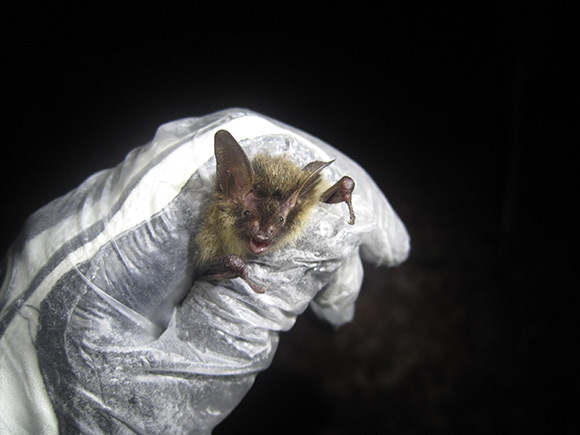
A northern long-eared bat being handled by researchers during population monitoring fieldwork. VTF&W Photo courtesy Morgan Ingalls.
The U.S. Fish and Wildlife Service’s (FWS) has reclassified the northern long-eared bat from threatened to endangered. This status went into effect at the end of March, largely due to the rapid and drastic decline in bat numbers caused by deadly white-nose syndrome disease. The bat received federal threatened status in 2015. However, following white-nose syndrome’s spread across the United States and Canada, the bat experienced dramatic population declines throughout most of its range. In Vermont, for example, the once-common species declined by 98% in underground hibernation sites. FWS issued final guidance in April, a planning tool and resources to cover potential impacts to development, infrastructure, and land management projects in the bat’s range. For more information visit https://www.fws.gov/species/northern-long-eared-bat-myotis-septentrionalis
Reducing New York Human - Bear Conflicts

An adult bear and her cub raid a bird feeder.
Groggy black bears across New York are venturing out of their dens and looking for their first spring meal. Adult males are usually the first to emerge. They may have lost up to 30% of their body weight, while females with nursing cubs emerge later and may have lost up to 40% of their body weight during winter. Bears are especially hungry in the spring due to depleted fat reserves and will search extensively for easily obtainable, calorie dense foods. While bears have plenty of natural foods, they also hit bird feeders, unsecured garbage, chicken coops, apiaries, or messy grills and pet food left outdoors. Continued access to these human food sources can make bears bolder, which can lead to an escalation in human-bear conflicts near residential areas. If you choose to feed birds in areas with bears, the New York Department of Environmental Conservation says you should empty and clean up spilt seed from feeders in mid-March, then let nature feed the birds from spring through fall. It’s also a good time to make sure garbage cans are bear proof, clean or remove all residual grease and food from grills, and store all pet food inside. Consider installing an electric fence around chicken coops or apiaries to protect your flock and hives. By taking time to remove or secure food sources that might attract bears you’re helping keep bears away from people, and that helps keep bears healthy, wild and safe. Do your part and encourage your neighbors to do the same. For more information on living responsibly with black bears, visit BearWise.org.
Slow Down, Give Turtles A Brake!
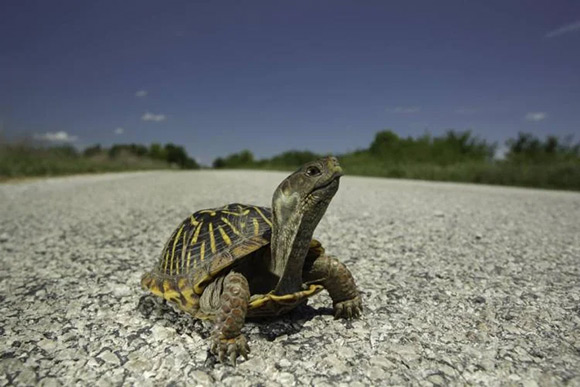
Ornate box turtles (pictured) are a species drivers may see crossing the roads this spring. MDC encourages drivers to slow down and give turtles a brake as they cross Missouri roads in search of food and a mate.
The Missouri Department of Conservation (MDC) is encouraging motorists to watch out for turtles crossing roads this spring. These reptiles are at special risk during spring because they are more active, looking for food and a mate. Common turtles spotted crossing Missouri roads include three-toed box turtles, ornate box turtles and snapping turtles. Turtles emerge from their burrows and begin the hunt for food and mates during warm and wet conditions. This leads them to cross roadways, often resulting in their death. Thousands of box turtles are killed every year by vehicles. Young males make up most of the travelers, sometimes wandering as many as 6 miles searching for territories and mates. Females also cross the roads searching for nesting areas. Turtles are cold-blooded and depend on external sources of heat to determine their body temperatures. This is why people see more on warm asphalt during cool spring days. Additionally, MDC urges the public to leave turtles in the wild. For more information on Missouri’s turtles, visit https://nature.mdc.mo.gov/discover-nature/field-guide/search/turtle.
MN lynx trapping rule changes
The Minnesota Department of Natural Resources (MDNR) has finalized trapping rule changes to minimize the risk of accidentally taking federally threatened Canada lynx in Minnesota. In February, Federal District Court Judge Eric C. Tostrud approved a settlement developed by DNR and the Center for Biological Diversity that includes additional limits on the type of snares used and the way these snares can be set in northeastern Minnesota. Minnesota lynx numbers are very hard to determine, MDNR says, but estimates put the population between 100 to 300. Since 2008, records show there was an average of one accidental trapping mortality of Canada lynx every other year. Trapping is not the leading source of human-caused lynx mortality in Minnesota – vehicles are. Trappers can find the specific snare-related changes for the 2023-2024 trapping season at mndnr.gov/trapping.
Oklahoma: No on Arrow Rifles for Archery Season?
The Oklahoma Wildlife Conservation Commission approved a position statement pertaining to proposed legislation moving through the state Senate and House of Representatives to allow the use of air-powered arrow rifles during any archery-only season, including Oklahoma’s deer archery season. The Wildlife Commission doesn’t support this. The commission recommends the legislature and governor veto or nix SB 352 and HB 2355. Air-powered arrow rifles are currently legal for hunting during any season that allows the use of rifles.
No CWD in Arizona Deer, Elk
The Arizona Game and Fish Department (AZGFD) says Arizona continues to be clear of Chronic Wasting Disease (CWD), a fatal wildlife disease that affects the nervous system of deer and elk. AZGFD has been testing for CWD since 1998. However, officials found no CWD in 1,199 animals – mule deer, whitetails and elk – sampled in 2022. AZGFD collected 354 samples from animals that were harvested and voluntarily submitted by hunters, and 845 samples through partnerships with game processors and taxidermists. While CWD has been found in Utah, New Mexico and Colorado, the disease has not been detected in Arizona. For more information visit www.azgfd.com/Wildlife/Diseases/
Henry Donates $25,000 to Pheasants Forever, Quail Forever
Henry Repeating Arms, a longtime supporter of wildlife and habitat conservation groups, donated $25,000 to Pheasants Forever and Quail Forever as part of Henry’s $1 million silver anniversary pledge. Driven primarily through donations and grassroots chapter efforts, Pheasants Forever and Quail Forever share a common mission of conserving upland bird populations and other wildlife through habitat improvements, educational outreach, public access, and conservation advocacy at the federal level. Since 1982, the two groups have improved more than 24 million acres and, together with local, state, and federal agencies, have acquired over 225,000 acres that will forever be protected for use by the public. For more information visit henryusa.com
Fur Harvesters Auction Results
In case you haven’t yet seen them, here are the results of the Fur Harvesters Auction from March.
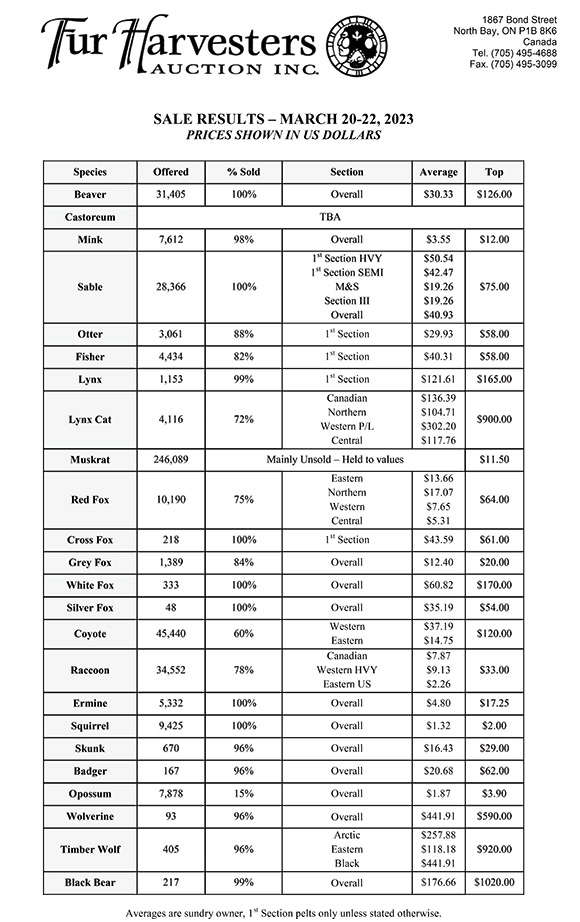
End of the Line Photo of the Month
Colton, Easton & Tarin Marohn of Braham, Minnesota

